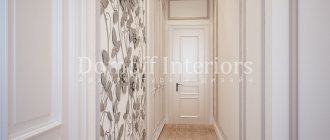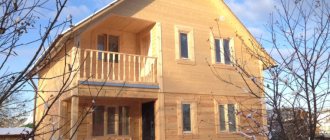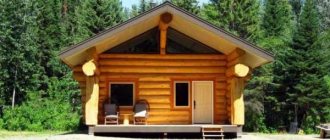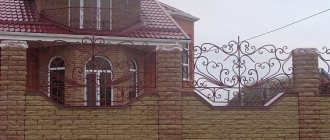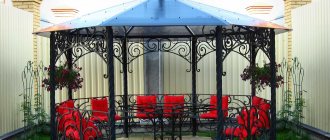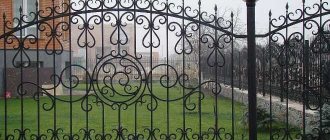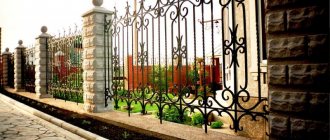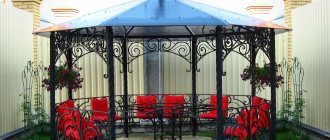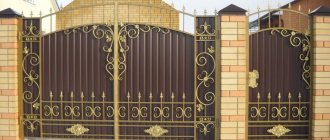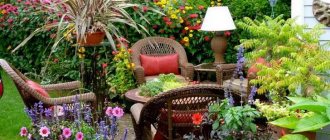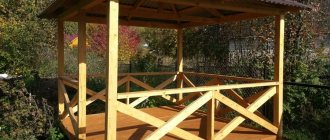Designer forged products in the interior are rich, exotic and grandiose. Despite their metallic composition, from which it is not so easy to create the desired ornament with the help of deft blacksmithing, they can be not only rough and monumental, as in bygone times, but also sophisticated, practical jewelry works of art, distinguished by their elegance, solidity and eccentricity of texture.
Designer forged balusters in the luxurious interior of a white living room act as a bright accent
Artistic forging - what is it?
It is the production of refined products by hot or cold processing of various metals and their alloys. Such items appear highly detailed, more reminiscent of jewelry work rather than simple craftsmanship performed with hammer, flame and anvil. Artistic forging is used not only to create external architectural elements of a building, such as railings, window grilles or gates, but also for more interesting paraphernalia, which in itself is of high value, since it is made by the hands of a master and, most likely, according to an individual sketch , no longer exactly repeatable by other creators. That is why forged accessories in the house are usually found in aristocratic mansions or expensive city apartments.
Artistic forging made of aluminum in a long corridor serves as a decorative component of the room
Look at the project : Interior of the Zhedochi house.
Equipment for forging metal at home
Without special (sometimes universal) equipment, machines and equipment, it will not be possible to obtain artistic products. Bending, pressing, and applying a pattern to the surface of the product is done using manual or machine tools. The following types of cold forging machines are used at home.
Gnutik. The device is designed for bending rolled products or strips at an angle of any size. The eccentric drive, bending die and hardened rollers are mounted on a solid base. If necessary, additional equipment can be added to this manual machine.
Cold forging machine PROMA Gnutik 0005
Snail. Creates products from rolled products in the form of a spiral located in the same plane. The main element of the design is the conductor, which is made in the shape of a curl, reminiscent of a snail. For each type of spiral, its own conductor is made.
Snail type machine PROMA. Photo VseInstruments.ru
Twister. The device makes it possible to twist the rods around their axis. The workpiece is fixed in the rotating head and slider and, using the handle, is twisted to the desired amount. When twisting, the length of the workpiece decreases, so the slider must be able to move along the axis.
Twister cold forging machine Blacksmith M3-TR
To obtain high-quality products, it is better to twist the rods around their axis using mechanized equipment. A twister, combined with an electric motor and a worm gear, provides a uniformly dosed load that cannot be provided manually. At the same time, it significantly reduces the effort that is required quite a lot when twisting the rods.
Flashlight. It is an interlacing of rods in the form of spirals elongated along a helical surface. By analogy with a twister, the design consists of a rotating head and a slider. An insert in the form of a shaft is added, on which the rod rests during winding.
Forging machine PROMA Basket Flashlight. Photo VseInstruments.ru
Wave. A hand-held device creates patterns in the form of rolling waves. A rod is passed between the two rollers and the stop. The movable roller, rolling over the stationary one, creates a wave-shaped bend on the rod. The wavelength is changed by increasing/decreasing the distance between the rollers.
Volna type cold forging machine
Globe. The workpiece is bent in an arc. The ends also bend depending on the author's fantasies. The basis for the device is a template in the form of an arc. There is a roller on the handle, which rolls around the arc when it moves. The workpiece, located between the roller and the template, takes the required shape.
Globe (volumetric) machine for cold forging. Photo ForgingPRO
The machine for bending profile pipes is a popular type of machine with lever control.
With your own hands
Welding machine with charger “SSVA-160-2”.
As can be seen from the description of the design of hand-held machines, it is quite affordable to make them yourself. To complete the work you will need the following materials and tools:
- steel sheets and strips;
- metal rods;
- steel square pipes;
- bearings;
- fasteners;
- angle grinder (grinder);
- welding machine;
- grinders for surface cleaning.
In addition to the skills of a mechanic, you must have the qualifications of a good welder. A high-quality weld is the key to the strength of any type of cold forging machine: snail, flashlight, globe and others.
In most cases, tools and devices are assembled independently.
Buy
With production volumes commensurate with the scale of a small enterprise, it is possible to consider purchasing equipment that performs all types of cold forging work. In the case of a stable range of products, an expensive manual machine: snail, bender or any other will pay off due to more productive work.
Cold forging machine Snail type Stalex SBG-30. Photo ForgingPRO
What types of artistic forging are there?
There are two types of artistic forging: hand-made (also called free-forging) or stamped, used for repeating decorative elements that require perfect symmetry (this is how staircase railings or mirror frames for furniture are made). There are also several methods of metal processing: cold (for soft compounds) and hot (for harder ones that do not bend mechanically without fire). Therefore, in the first case, the blacksmith first shapes the product and then fires it, and in the second, he heats up a piece of metal, and then works with it, gracefully shaping it by chopping, stretching, bending, twisting, upsetting, smoothing and incising patterns.
Stamped artistic forging in a perfect symmetrical pattern on the stairs and railing of the upper floor
Interesting about metal forging
How to make a snail for cold forging with your own hands?
Interesting fact, one of the most common surnames in the world comes from blacksmithing. This is Kuznetsov in Russia, in France - Ferrand, in Britain - Smith. This indicates the prevalence of this craft throughout the world.
blacksmith craft
The basis of the word deceit is the verb forge. The fact is that many peoples and tribes considered blacksmithing to be obscure and shrouded in mystery. Kovar (blacksmith) makes forges, knits shackles, so over time the noun cunning denoted wisdom, skills, ability. Over time, it began to mean evil plans and intentions. At the same time, the phrases “forge your happiness” and “forge your destiny”, which have a positive meaning, also appeared.
During the mass unification of production and the use of equipment such as rolling, stamping, the use of computer control practically displaced blacksmithing from heavy industry, but it remained and is popular with designers and interior design specialists. Modern blacksmiths make products that are used to create fences, stairs, architectural design of buildings, etc.
But our century has led to the fact that the design of forged products is carried out using special 3D design programs intended for the development of parts for various purposes.
Open forging is used on a variety of metals. With the help of this operation, both household items and objects of artistic value are performed. By the way, this method of metal processing is also used in jewelry. In fact, the most malleable metal is gold. It has plasticity, fluidity, ductility and many other properties that make it possible to obtain priceless products from it.
Jewelry forging
Casting or forging in the interior: which is nobler?
Both methods of shaping metal are widely used to enhance decorations. Cast objects are made using flasks, so they can look bulkier and more solid, somewhat reminiscent of factory production. Large parts are most often cast from cast iron alloys, smaller ones from tin or bronze. Forged products for decorating houses and apartments are distinguished by their originality, the merit of which lies in the handiwork of the master. Even if stamping is used, unique pieces with high-quality detail are obtained. For forging, the most commonly used metals and their alloys are steel, bronze, aluminum, brass, titanium, Damascus, copper, etc. Whether casting or forging, it all looks rich, luxurious and first-class.
Artistic casting in the interior of a classic kitchen using the example of a blown table leg
Tools and equipment
A manual cold forging machine includes a number of elements. Necessary equipment that will be needed for work:
- twister;
- snail;
- gnutik;
- wave;
- globe;
- flashlight.
The main tool for the work will be a bender, which is used to change the shape of the metal. Its function is to bend a part at the required angle or bend arcs with different radii.
The snail is used, as a rule, for twisting steel rods into spirals. This is equipment for bending rods, strips, tubes, squares and profiles into a spiral shape, products with various shapes and radii. When using this tool, you can not limit the radius of the created spiral and make the size that is required.
The flashlight tool is necessary for bending metal parts. It is used to process metal rods with a cross-section of less than 30 mm, or square profiles with a cross-section of less than 16 mm.
Using a device such as a wave, wavy curved elements are made. It is also used for processing pipes that have a hexagonal or round cross-section.
Twister is somewhat similar to a flashlight. Using these two tools you can twist the rods around the axis.
Using a globe, you can make a large arc from a profile rod up to 12 mm thick. Moreover, the ends of the workpiece also bend smoothly.
This tool for cold forging is absolutely not complicated, so you can often see homemade ones. It is almost in no way inferior to the factory one.
https://youtube.com/watch?v=lXzm3RtqxS8
Forged products and other materials: what to combine with?
If we talk about materials with which forged interior items go well, then these will be all natural or light-reflecting types: wood, cork, stone, glass, mirror, as well as living plants: they always look great next to openwork forge items. It is impossible not to note the fact that metal is ideal next to other metal. The main thing is the very texture of these products and the style of the room where they are located. Forging and casting can organically fit into both classical and modern trends; the type of line itself is important: straight, angular, strict or smooth, lacy, convex.
Forged carved elements in the classic interior of a spacious hall look good next to marble and plaster stucco.
Artistic forging in the interior
Motifs of manual labor and ancient crafts are becoming increasingly popular. Metal work and forged products in the interior are an undoubted trend of the last two seasons and a universal art object for decorating an apartment, made in any style and design.
Styles and directions
Decorative forged elements are good for their stylistic versatility: they fit perfectly into both classic and avant-garde interiors. However, it is necessary to take into account the general character and style of the direction and support them in the lines and plot of the forged product.
Provence
For example, artistic forging in a Provence style interior will be expressed in fluid smooth lines, floral and plant motifs. Openwork armrests, backs and legs of furniture, railings and fireplace grates perfectly convey the cozy, homely, rustic mood of this style.
Loft
Forged interior parts in the loft style, in turn, should be made in rigid and geometric shapes. The interior will be perfectly complemented by interior partitions and screens, minimalist tabletops on forged legs, high bar stools made of metal and thick plastic.
Baroque
Stylization under the Baroque era is the most fertile ground for the sale of forged products in the interior of your home. Heavy chandeliers, candelabra, ornate frames for screens and mirrors, and headboards are literally imbued with the spirit of luxury, mannerism, and courtliness inherent in the Victorian era.
Color and texture
A stylish and universal technique - playing on contrasts - is easily realized by introducing heavy forged parts made of dark metal into a delicate pastel palette.
The interior of a bright apartment with forged elements, regardless of the style, looks elegant, voluminous, multi-layered, but does not overload the eye.
Just a few forged parts are enough to set the tone for your home. This could be a coffee table with wrought iron twisted legs or even ornate frames for your family photos.
It must be remembered that forged items in the interior are very “talking” details, so the background for them should be chosen laconic and calm, then visual harmony will be preserved.
Kitchen and dining room
Decorative forging in the interior of the kitchen and dining room has enjoyed stable success for the past three seasons. In addition to high aesthetic properties, forged elements in the interior are practical to use and easy to clean.
To add charm and character to the appearance of your kitchen or dining room, just replace the standard handles of the kitchen set with openwork forged ones. This seemingly insignificant detail transforms the most budget kitchen corner and adds chic and gloss to it.
You can also place forging elements on the walls in the kitchen interior. Metal hooks, heated towel rails, and shelves for dishes organically combine practicality and aesthetics.
Living room
Speaking about forged interior items, most often we imagine forging in the interior of the living room, and above all thanks to the fireplace. Country house owners rarely miss the opportunity to “tame fire.”
The cozy crackle of burning logs and the glare of flame passing through the patterned grate of the fireplace in themselves fill the house with comfort and tranquility. In addition, a metal shield made of tightly woven rods will protect you and your loved ones from sparks and burning coals, and will prevent fire and damage to the floor and carpets near the fireplace.
Hallway, corridor, staircase
Apartments in standard buildings, as a rule, do not provide large hallways and spacious corridors. But for those who like to get the most out of a minimum of resources, these rooms can become an additional art object. By placing carved shelves or even forged panels on the walls, you will enliven the corridor space.
Forging in the interior of the hallway will find an organic place in storage sections, hangers, forged umbrella stands, overshoes, or simply in a series of hooks placed on the wall.
Twisted stairs with high railings are not only a matter of aesthetics, but also of safety. The carved or forged stairs and railings themselves act as a spectacular accent in the interior. The “air” in the metal lace of the railing will visually expand the space and reduce the dimensions of the staircase structure.
Bedroom
A king bed with a high wrought-iron headboard is a luxurious gift for those who like to combine aesthetics and comfort.
A bed with forging in a bedroom interior always looks advantageous and presentable. In addition, such furniture will not eat up space: a wrought-iron bed in the bedroom interior will visually dissolve and will not look bulky and heavy.
Forged beds in the bedroom interior are especially close to the tender hearts of girls. A cozy boudoir with a bed with an openwork headboard, a banquette or a dressing table with forged curved legs will appeal to your teenage daughter.
Exterior
Speaking about forging in the interior of a country house, we should say separately about outdoor furniture.
Forged metal is simply created for the design of a veranda, garden or terrace:
- garden tables and chairs,
- swing,
- benches and even barbecues, decorated with ornate forged elements,
- as well as forged cornices, storm drains, flowerpots, street lamps.
All this will organically take place, the list can be continued ad infinitum.
Using the same set of wrought-iron furniture, you can use pillows and textile covers of different colors, textures and styles, thereby updating the look of your garden at low cost.
✽ ✽ ✽
One way or another, forged elements in the interior or exterior, combining flexibility and strength, will undoubtedly become a feature of your home or apartment.
What interior styles do blacksmith products harmonize with?
1. Empire style is one of the best styles that are friendly with forged objects, because the direction itself favors military or victorious symbols, where elements such as spears, armor, torches, arrows, traditionally made of metal, are often found. Empire forging lines are simple, but clearly detailed.
Forged decorative elements in the Empire style decorate the bathroom with their warm metallic shade
2. The Gothic style in general often consists of dark cast-iron objects of blacksmith's creativity, which, on the one hand, are clear, straight, tending to regular symmetrical circles and triangles, on the other hand, intricately woven, complex and pointed. Forging lines in Gothic often resemble thorny plants such as ivy, burdocks, roses with thorns (or they imitate them).
The gothic wrought iron staircase in its natural dark incarnation luxuriously decorates the hall
3. Classic is proportional, symmetrical, clearly measured and strict. Forging in it is subject to regular geometric shapes: squares, circles, rectangles and ovals. There are also other elements such as knots, rosettes, weaves, leaves and flowers - always balanced and well-designed.
Wrought iron frames of classic furniture in a huge, elegant bedroom in cool colors
4. Renaissance and forging can also go side by side, since the style of the Renaissance is very diverse and divinely textured: in it you can find graceful animals (especially lions), and mythical massive sphinxes, and even aesthetic silhouettes of naked bodies of men and women, as well as wreaths in the form of a coat of arms and other elements of plant motifs.
Artistic forging in the Renaissance style in fine hand-crafted detail on restroom furniture
5. The Greek direction is distinguished by simplicity of forms, therefore artistic forging in it will be devoid of abundance and excess, but not of its individuality. It can resemble architectural elements of antiquity (arches, columns) or take the form of simple ornaments without being intrusive. If these are plants, then they are often fruity; if they are human figures, then they are close to natural.
The natural outlines of the figure of a predatory animal in a rough forging style are characteristic of the Greek direction
6. The Roman style is aesthetic, it has absorbed many of the different trends, and has taken shape in a luxurious bouquet consisting of the most beautiful forms. Forged products for the interior will be lush flower garlands, lush grape vines, windblown ears of corn, oak leaves and beautiful human figures.
The staircase in the Roman classic interior of the hall is richly decorated with forged parts and gilding
7. Baroque favors forging, especially covered with gold, platinum or silver, and even better, made from them. The more expensive the non-ferrous metal, the closer it is to this idle style, filling it with high cost and pomp. The lines are usually massive and curved, rushing towards ovals and curls: acanthuses, shells, trellises. The style may include forged dragons and various mythical deities.
The luxurious headboard is carefully crafted with forged elements from the Baroque style
8. Rococo did not move too far away from Baroque, abandoning excessive pretentiousness, but still became unique due to its asymmetry. The forging in it is more artistic and finely detailed, not so heavy, but still flashy and making its value known. There are rocailles and palm leaves, nymphs and cupids covered with expensive non-ferrous metals.
A forged ceiling chandelier with imitation candlesticks and light gilding can be in the Rococo style
9. Art Nouveau is also not complete without forged decorative elements, which can be located in any corner of the decoration. The lines will be completely unobtrusive and not conspicuous: straight, slightly wavy or simplified floral. The softer the geometry, the better.
The black wrought iron modern partition in its simple and laconic lines adds charm to the hall
10. Art Deco looks very organic with forged objects, since the style itself loves everything unusual and worth a large investment. Metal lines will be symmetrical, repeating and laconic (circles, triangles, squares, zigzags), reminiscent of the classics and its love for ideal proportionality.
A forged mirror of an unusual metallic shade will fit perfectly into an Art Deco interior
Look at the project: House design “Millennium Park”.
Do-it-yourself cold forging under pressure: creating blanks for forming products
DIY roses made of tin.
DIY metal flower DIY tin rose drawings On wrought-iron fences you can often see not only geometric patterns, but also flowers, butterflies, leaves and other decorative elements. They are also made using cold forging techniques, but by rolling rather than stamping.
Do-it-yourself volumetric forged products are made from sheet metal. Working with a press at home is less common than rolling. Extrusion of sheets under a press can be either manual (knocking and pressing) or automatic. At home, it is cheaper to use hand stamping. To do this, the master needs to make several blanks that will be printed on a metal sheet under pressure.
A drawing of the future forged product will greatly facilitate the work of the craftsman.
Metal forging equipment:
- Punch (press stamp or cotter pin) is the upper part of the press, it pushes the sheet inward. The pressing side of the stamp can be drawing or smooth.
- Matrix is an element that is made in the shape of the required object. The applied relief deforms the plate under pressure, giving it the required shape.
- Press lever - a handle or relay for bringing the dies closer together and adjusting the force of the press.
Before starting work, you need to create a drawing of the future product. Sketches of artistic forging are transferred to the workpiece, it is cut and ground along the edges. You can use a regular vice as a workbench for pressing. It is most convenient to place them in a vertical position so that the plate lies horizontally to the plane. This way, the plate will be positioned exactly between the dies and will not slip out when the lever is rotated.
Different types of workbenches allow you to create unique forged elements.
Simple forging of metal at home can be done with a chisel and hammer. In this case, the chisel acts as a punch, the anvil as a matrix, and the hammer as a lever. To better print the design, you can put a plate with notches under the sheet. This way the relief will be clearer and more beautiful.
Note! The metal used for stamping must be softer than the punch and die. Otherwise, the tools will quickly break
To make the “sheet” element, a blank of the desired shape is cut out of a metal plate 20-30 mm thick. A longitudinal line is drawn on it with a pencil in the center. The chisel striker is placed at an angle to this straight line. After hitting the handle, a line is imprinted on the plate, similar to the veins of leaves.
The cold forging method can be used to create three-dimensional elements.
You can use pliers to form the required volume of a cold forged product. The part is clamped between a vice and bent into the desired shape. This type of work is well suited for completing a small number of items for personal use. The process of beating a pattern by hand takes a lot of time, it is quite monotonous and requires great precision.
It is more profitable to purchase stamps for permanent work (in the form of leaves, petals, flowers, etc.), since accurately turning two identical elements is a very complex process. The main parts are machined from a blank or cast by hot forging. This type of work requires a lot of experience and high precision. The punch and die must match. With strong pressure, irregularities will be imprinted on the product. If the discrepancy is very large, then the press will crush the workpieces - and you will have to start work from scratch.
Exterior and architectural components of the interior in rich artistic forging
1. The exterior of the mansion in all its glory can be framed with detailed elements of blacksmith work. Metal is used to decorate fences and gates, knocker handles, window openings and balcony railings, balusters and consoles, gazebos, benches and barbecues, bridges, pond fencing, lanterns, pillars and flower stands.
Cast iron forged lanterns and bases for the soft area look aesthetically pleasing next to the green wall
2. Architectural parts of the interior decoration can also be made of forged metal, for example: complete stairs or their component parts (steps, support pillars, balusters, railings, covers and finials), also fireplace parts such as grates, various partitions for zoning space , door and window handles, etc.
The ironwork on the doors in the dressing room is painted white to add a soft touch to the interior.
Luxurious furniture from the author's blacksmith shop
Furniture is increasingly being forged according to an individual design project in order to acquire these non-trivial forms necessary for chic. It looks expensive, and the price list is no less. But it’s definitely worth it, because it’s difficult to find even two identical examples of handmade art. From openwork metal worked by a blacksmith, completely unique details can be created that adorn the headboard of the bed, frame couches, chairs or armchairs, enhance the legs under the bathtub, support the bases of dressing tables, and subtly complement the doors of wardrobes, sideboards, and kitchen units.
Chic wrought iron edging on sofas and armchairs along with cast high tables in a classic living room clearly transforms the interior
In general, all custom-made forged furniture is a whole work of art created by professional craftsmen. And to achieve a truly rich and luxurious design, you need to think carefully about every component. You need some parts to match antique items - please make some vintage metal elements like chests or bedside tables - and here you can’t do without forging. Fortunately, advanced technologies make it possible to use artificial aging methods to create a white or greenish patina, and it always looks spectacular in aristocratic country palaces or luxury apartments in a classical or empire style, as well as in eclecticism, art deco, baroque and modern, not excluding modern trends. Forged furniture will turn the family estate into a real royal palace, which will serve as a prominent representative of the surrounding architecture.
Gilded table in ethnic style made by hand-made artistic forging
Basic patterns
Since iron can change shape during heat and physical treatment, there are various examples of forged patterns. All of them can be divided into three main groups:
- Geometric.
- Vegetable.
- Animals.
Undoubtedly, the most popular of them are floral forged ornaments. The artful interweaving of branches, flowers and leaves has always inspired artists to create fantastic works. Blacksmiths are no exception in this series. They also often use plant motifs in their work.
To make a similar pattern, you need to follow the forging technique
For cold working, metal rods are most often used as the main material. They are bent, twisted, flattened, minted, milled and forged. The end result is magnificent works. Here are the main elements and techniques for this type of metal work:
- Curls. The most popular element. It has a huge number of different options and modifications.
- Spirals. Single, double, spatial and others. This is also a very popular technique that makes patterns for forged products memorable and original.
- Cool. Twisting iron bars can be the most incredible experience. The imagination of some authors is amazing.
- Top. A decorative insert or special atypical treatment of the ends of the rods can greatly diversify and decorate any ornament.
- Coinage. The use of chisels and hammers for decorative inserts in forging patterns is a long-proven and often used way to add creativity to a future creation.
- Headings. Cylindrical, cone-shaped, spherical elements made of rolled metal, attached to the end of a rod.
Forged decor in the interior
Functional interior items or decorative elements are simply magnificent if they are made through blacksmithing: designer forging or casting. Burnt metal produces completely unique works: baskets for umbrellas, floor and wall hangers, openwork frames for mirrors, clock frames, folding screens, stands for potted flowers, small furniture fittings, vases, panels, candlesticks, as well as ceiling chandeliers, sconces, floor lamps and bedside lamp legs.
Forged furniture handles in gray metallic color make the white master's dressing room more delicate and sophisticated
The products magically fit into the interior; they exude elegance, texture and pretentiousness. Each forged item has its own unique creation history and metal composition, distinguished by unique characteristics. Therefore, handmade motifs are becoming more valuable and popular every year, not only due to their beauty, but also to their durability. Blacksmith decorations in design are undoubtedly a fashionable and popular attribute for decorating any room.
Photo frames in the spacious bedroom are made by hand forging
What is the color of forged or cast metal?
If we talk about the color of forged products, then it can be a shade of the manufacturing material itself, without changing its metallic appearance of natural origin (aluminum, steel, cast iron, nickel, copper, etc.). Objects made by a blacksmith are often doused with various chemical compounds that give an unusual effect, and are also covered with precious compounds. Modern technologies make it possible to create a slightly moldy patina that will look great in a classic style, or to luxuriously gild details, such as in baroque, rococo, eclecticism, art deco, ethnic or oriental styles. Products made from alloys like Damascus steel look incredibly beautiful, especially if it is a victorious Empire style.
The modern fireplace is skillfully decorated with unusual forged elements with a slight blackening
Hall and hallway
Perhaps the most popular place for installing large forged objects is the hall, since it is there that an unusual staircase can be located: either made entirely of cast iron, or having most of the components made of some kind of metal, coated with silver, gilding, or plainly painted white or another color. Openwork balusters and railings are where the aesthetics and spirit of a real castle lie. Cast steps and carved railings in the interior will certainly become the main accent of the room, which you will want to look at every time it comes into view. The hallway can also be decorated with various forged items, showing with all its appearance that this is the home of art lovers.
Gilded forged product of the author's handicraft as a wall table in the hall
The classic hall with a wide staircase is professionally decorated with white painted wrought iron elements
Openwork forged parts of an unusual color with a cold undertone on the stairs and railing of the second floor of the classic hall The designers ennobled the hall of the second floor of a country house with a forged shelving to enhance the effect of stylish antiquity
Living room or hall
Forged products in a spacious living room are always aesthetics and an indicator of refined taste. Strict geometric patterns or laconic designs will help decorate classic interior styles, especially English or chateau. More abstract forms are better suited for modern, neoclassical, loft or mixed modern trends. You can order a family coat of arms from the designers, which will then become a metal part of the room in the form of a fireplace grate, candlesticks, table lamps and other components, turning an ordinary room into a family treasure.
The living-dining room with decor in the form of forged figurines of people and animals looks extravagant
Wrought iron balusters and railings on the stairs in the living room for receiving gentlemen
Forged legs of coffee tables enhance the eclectic interior of the living room
Abstract forged decor on the wall and a figurine of a human figure above the sofa look modern and stylish
Styles and elements of patterns: photos of artistic forging
Creating a beautiful pattern begins with a forging sketch. The master must have a clear idea of the picture he wants to make. Initially, a drawing is drawn, materials and the number of necessary elements are calculated, machines and equipment are selected. In order for the product to look beautiful, it is better to immediately choose the style in which it will be made. Looking through photos of cold forged products, you can easily notice which direction the pattern belongs to.
Beautiful forged products can be made in various styles.
There are several styles of forming a forged pattern.
The Romanesque style is characterized by severity and symmetry. On the fences you can see a dense arrangement of spirals in the same order, the details are often repeated and of the same type. This is a monumental pattern using the volute element (C-shaped twisted one-sided curls).
Gothic ornament. Few people know that modern fencing and fences are most often made in this style. A characteristic feature is upward striving. The rods are pointed and end with tops in the form of arrows, spears or sharp spikes. The spiral elements used in this style are called perforations, and they look like a stem branched in different directions. For variety, lanterns or voluminous spirals are added between the straight rods.
Products in the Baroque style are the most common.
Renaissance is very rare. In this style, pointed charcoal elements are practically not used. The basis is round arcs, spirals and waves. The branching metal rods are decorated with leaves or flowers; graceful curves take the shape of a figure eight. Characteristic elements are notch, spiral, volute and figure eight. The style is very harmonious, the details are installed symmetrically in the form of intertwined lines.
Baroque is the complete opposite of Renaissance. The style is openwork and very lush. C-shaped spirals, volutes, curls, curved lines and intricate patterns are used. Three-dimensional leaves and flowers are added to the weaving, creating a dynamic shape.
Rococo. This direction is characterized by the use of thin rods and double-sided curls. The rocaille ornament creates constant movement and is distinguished by filigree and three-dimensional patterns. In the photo of cold forging, asymmetry and fractional patterns are noticeable. The use of straight rods and flat gratings is unacceptable.
The classic style allows you to combine various forged elements.
Classicism. A beautiful, albeit simple style that brought symmetry back into fashion. To create an ornament, curls, perforations, spirals and straight rods are used. Another element is introduced into use - a meander (broken lines or rods bent at right angles). Vertical architectonics are always strictly maintained in fences.
Empire style is characterized by the presence of geometric patterns and long smooth rods. The main element (volute) is modified: an elongated straight line with one-sided curls at the ends. The main thing for this style is strict simplicity, symmetrical geometry combined with spiral elements.
Art Nouveau, or Art Nouveau, added biological motifs to do-it-yourself artistic forging. The style does not use straight lines, only various bends, meanders, curls and spirals. Symmetry fades into the background. The ornament repeats the silhouette of a person or animal, leaves and flowers are added. The pattern is constructed in such a way that the curls evenly flow into each other throughout the entire ornament.
It is difficult to create a beautiful forged pattern without a drawing.
If a person starts work without a preliminary drawing, he will quickly get confused in creating a cold forged product. Each pattern should be thought out as much as possible, and it is better to immediately transfer edits that are made during work to the sketch in order to clearly understand what the result should be.
On a note! Even if you have photos of forged patterns, you need to make drawings and markings to accurately place all the parts.
Kitchen and dining area
Furnish an already exquisite kitchen with forged decorative elements or furniture made by a blacksmith - and the royal island is ready not only to receive the owners, but also their guests, surprising with the beauty of the curling details. The table leg, chair backs, handles on the hinged doors, shelves for dishes, hooks, bottle stands will add amazing charm to any cooking area or dining area for everyday meals and entertaining invited gentlemen.
The forged edging of a wall clock in a classic elegant kitchen adds charm to the decor
Black forged lamps in the Gothic style look very unusual and elegant
Metal decor in the form of flowers on the kitchen wall is made by hand-made artistic forging
Bedroom
A sophisticated bed with a chic high back in the bedroom interior is noble, amazing, and comfortable. A royal box can be created precisely with the help of a forged frame of the body, which is some kind of floral intricacies with roses, peonies, maple leaves, rocailles and other curls. To get a full-fledged set of furniture in the same style, you need to support the metal headboard, doing this by introducing additional forge products into the interior: sofa edging, curved legs of the dressing table, photo frames and other openwork details from that composition.
Forged decor for sconces in a fashionable and modern classic bedroom
Forged furniture frames in the luxurious classic interior of a large bedroom Forged bases of table lamps in their gilded version serve as a bright accent of the bedroom
Types of beautiful forged structures: transparent, with the addition of tin and other materials
Useful things for the home with your own hands
Forged structures combine the qualities of aesthetics and functionality. They are assembled from different materials (stainless steel, metal sheets and profile pipes) and are complemented by elements made of polycarbonate, corrugated sheets, tin, sheet metal, wood, stone, concrete.
Forged gates according to the degree of openness are divided into:
Transparent. They consist of vertical balusters and intertwined metal rods that create beautiful ornaments and patterns. Classic products do not hide the garden plot from prying eyes, and the owners will not be able to privacy in their yard.
Forged transparent swing gates. Photo by IP Ninety
Closed. They completely hide from passers-by not only the landscape design, but also the house itself. Blind products combine openwork forging and inserts from other materials.
Blind gates with wood and forging. Photo: Forging manufactory of Valery Litvinov
Wooden and forged structures and products with corrugated sheets are in demand.
Gates and wickets made of corrugated sheets with forged elements are made in the same style. Photos Oboron-stal
There are also models with polycarbonate and sheet metal.
A popular combination is forged gates with brick pillars.
According to the method of opening, forged gates are:
Swing. The designs are simple in design and do not require special maintenance. They can be mechanical (opened manually) or automatic (opened using a remote control). They open both inside and outside the yard. The choice in favor of swing structures should be made based on the availability of free space and the personal preferences of the owners.
Sliding gates with stamped elements. PhotoTHREE MARIE
Retractable. They are ergonomic and save space. The operating principle of sliding structures is quite simple - the gates move in different directions along specially installed rails.
Attention. When choosing decorative elements for sliding gates, keep in mind that when opening they will be hidden behind a section of the fence
Therefore, voluminous and massive ornaments are not recommended.
According to the degree of decorativeness, forged gates are divided into:
Products with simple designs. These include standard gates without frills or decoration. They serve a purely practical purpose, are durable, reliable and easy to use.
Forged single-leaf sliding gates with a laconic design. Photo Deroy
Decorative. They are decorated with a large number of elements: curls, flowers, leaves, baskets, figures, inscriptions, vines, etc.
Forged sliding gates with elements: peaks, rings, commas. Photo KovArt
Bathroom
Increasingly, forged decorative items can be found in restrooms.
And it is not surprising, since many metal products, for example, stainless steel, do not corrode, and if over time they acquire some undesirable shade, then this is fixable and not at all so critical, especially in comparison with short-lived materials that deform from constant humidity. Therefore, in luxurious mansions, bathrooms are richly decorated with paraphernalia made by the hands of a master blacksmith. These can be laconic carved legs for an oval bathtub standing in the middle of the room, a wall-mounted lace cabinet for a washbasin, twisted edging of large mirrors, as well as sophisticated sconces and hanging chandeliers. Forged products are an unconditional exclusivity that will never go out of fashion. Forged elements of a strict modern type indicate a clear elaboration of the style of the bathroom
The silver bathtub legs are hand-forged especially for this bathroom design project
Elegant wrought iron details on the sink and mirror complement the classic style of the spacious powder room.
